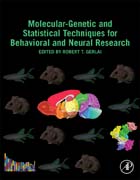
Molecular-Genetic and Statistical Techniques for Behavioral and Neural Research
Gerlai, Robert T.
Molecular-Genetic and Statistical Techniques for Behavioral and Neural Research provides an informative and up-to-date account of the most modern molecular and genetic techniques and their use in biomedical research, behavioral and neuroscience studies, and, finally, disease diagnosis and research at a molecular level. This new work is a reworking of Elsevier's original Handbook of Molecular-Genetic Techniques for Brain and Behavior Research (1999) serving as an all-encompassing, updated reference that expands on techniques first described there in the wake of multiple revolutions in DNA technology including the Human Genome Project. Beginning with an introduction to genomic research, this illustrated work extensively discusses relevant experimental techniques, both basic research and translationally relevant, and also examines several species as model systems including Mus musculus, Drosophila melanogaster, Caenorhabditis elegans, and Danio rerio. It is a critical resource for clinicians, researchers, graduate students, and advanced undergraduates, as well as professors teaching in relevant disciplines. Introduces the relevant aspects of genomic research and neuroinformatics to neuroscience researchersDescribes the principal methods used to study brain and behaviorConsiders bioinformatics, genomic research, and molecular biology strategies for phenotypic analysisIncludes discussion on both forward and reverse genetic approaches and genetic animal models of human diseases, and a section on ethical concerns arising from these methods and their applications INDICE: Section I: Neuroinformatics, Computational Models and Data Analysis 1. Neurological Biomarkers and NeuroInformatics: The Role of The Virtual Brain 2. Informatics for Interoperability of Molecular-Genetic and Neurobehavioral Databases 3. The Allen Brain Atlas: Towards understanding brain behavior and function through data acquisition, visualization, analysis and integration 4. ExAtlas: On-line tool to integrate gene expression and gene set enrichment analyses 5. Computational Models: How do they help to understand neurological diseases? 6. The Use of Recombinant Inbred Strains in Systems Genetics and Functional Analyses in Behavioral Pharmacology Section II. Searching for New Genes: Natural Genetic Variation 7. Spontaneous versus induced mutations: Conceptual and methodological considerations for the neurobehavioral geneticist 8. Reduced complexity cross design for behavioral genetics 9. Collaborative Cross as the next-generation mouse genetic reference population designed for dissecting complex traits 10. Discovery of novel genes and other lineage-specific features through comparative genomics 11. Using signatures of directional selection to guide discovery Section III: Discovery of New Genes and New Functions of Genes Using Gene Expression Analyses 12. Using Transcriptomics to Study Behavior 13. Genes, Behavior and Next-Generation Sequencing - The First Ten Years 14. Abnormal social behaviors and dysfunction of autism-related genes associated with daily agonistic interactions in mice 15. Epigenetic mechanisms of learning and memory Section IV: Discovery of Genes and Biological Mechanisms: Forward Genetics and Other Screening-Based Methods 16. Systematic screens in zebrafish shed light on cellular and molecular mechanisms of complex brain phenotypes 17. The transition of zebrafish functional genetics from random mutagenesis to targeted integration Section V: Manipulating Known Genes to Understand Biological Function: Reverse Genetics 18. Molecular Techniques Used to Explore Glutamate Receptors in Synaptic Plasticity and Memory 19. Using Herpes Simplex Virus Type-1-Based Amplicon Vectors for Neuroscience Research and Gene Therapy of Neurological Diseases 20. Cre-lox neurogenetics: history, present and future 21. Functional Analysis of Proteins Involved in Neurodegeneration Using the Model Organism Dictyostelium: Alzheimer's, Huntington's and Batten Disease 22. The role of human endogenous retroviruses (HERVs) in the pathologies of nervous system 23. Optogenetics dissection of sleep circuits and functions 24. The use of DREADDs for dissecting the contribution of cellular and neural circuit mechanisms in models of neurodegenerative disease Section VI: Ethical Considerations 25. Genes and human behavior: Ethical implications 26. Ethical Considerations for Animal use in Behavioral and Neural Research
- ISBN: 978-0-12-804078-2
- Editorial: Academic Press
- Encuadernacion: Cartoné
- Páginas: 702
- Fecha Publicación: 01/06/2018
- Nº Volúmenes: 1
- Idioma: Inglés
